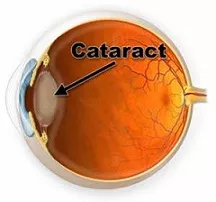Why is implantation of the Hydrus stent necessary?
The Hydrus Microstent is implanted to decrease eye pressure. It can be implanted on its own, or combined at the same time as cataract surgery for patients who have both cataract and glaucoma. In some patients, the stent reduces the number of pressure-lowering eye drops used. In some cases, it may be possible to stop all pressure-lowering eye drops completely.
The lens is the middle window inside the eye that focuses light entering the eye. As you age, your lens becomes gradually more cloudy – this is called a cataract. As the cataract progresses, you may experience worsening vision and increasing glare. During cataract surgery, the cloudy lens inside your eye is removed and replaced with an artificial clear lens implant. The lens implant remains in the eye permanently.


Fluid in the eye (aqueous) is produced by the ciliary body, and drains out through the trabecular meshwork (drainage pathway) in the drainage angle. Sometimes the trabecular meshwork no longer copes, preventing aqueous from draining out easily. This causes pressure to build up in the eyeball. When the pressure in the eye is too high, it can cause optic nerve damage and permanent vision loss – this is called glaucoma.
See Related:
Surgical treatments for glaucoma
Surgical treatments for cataract
What does the Hydrus Microstent do?
The Hydrus Microstent is one of the glaucoma surgery techniques called minimally invasive glaucoma surgery (MIGS). In contrast to traditional glaucoma surgery, MIGS is quicker and easier to perform and has less risk of complications, but has reduced overall pressure control.
The Hydrus Microstent is made of nitinol and measures 8 mm long. Implantation of the Hydrus stent involves puncturing the stent through the trabecular meshwork. This creates an opening in the trabecular meshwork which allows aqueous to drain out in a controlled manner, thereby reducing eye pressure.

There is no change to the way the cataract surgery is performed. The stent is implanted into the trabecular meshwork after the lens implant has been inserted into the eye. This adds around 5 to 10 minutes to the overall cataract surgery time.
See Related:
iStent implantation for glaucoma
CyPass micro-stent implantation for glaucoma
What are the potential risks?
The Hydrus Microstent is very safe. It is inert, well accepted by the eye, and safe for Magnetic Resonance Imaging (MRI). Apart from the usual risks associated with cataract surgery, additional risks specific to the Hydrus are usually self-limiting and not sight-threatening. These include:
● Bleeding into the eye. This is generally mild and settles over a few days.
Rarely the bleeding can be severe, causing blurred vision for a few months.
● Stent implantation issues, such as implantation at a non-ideal location,
depth or angle. Rarely, the stent may become dislodged from its implanted
position requiring an additional procedure to reposition the stent.
● Failure to work. It is possible that the Hydrus stent may not work in your eye
despite successful and uncomplicated implantation. Sometimes the stent
works well initially, but the pressure gradually increases over time. If this
occurs, you may need to restart your glaucoma eye drops.
● Infection side the eye (endophthalmitis). This is the most serious
complication, and can cause permanent sight loss despite treatment
with antibiotics and surgery.
See Related: Risks and complications of glaucoma surgery
What should I expect?

Hydrus Microstent implantation (combined with cataract surgery) is a hospital-based day case procedure performed under local anesthetic. The operation is usually performed one eye at a time.
Before and during surgery:
All the instructions before and after surgery are the same as for cataract surgery. All the precautions and surgical steps taken are the same as for cataract surgery. The following are the extra steps that will occur during Hydrus Microstent implantation:
● You will be asked to rotate your head to one side. Please remain still during
the procedure.
● A contact lens will be placed on your eye.
● The stent will be implanted. You should not feel any pain during implantation
of the stent.
After surgery:
After cataract surgery and Hydrus Microstent implantation, a pad and shield will be placed over your eye. The pad and shield can be removed the next day, and you can start your normal postoperative eye drops, usually a steroid (Prednisolone or Dexamethasone) 4 times daily for 3 to 4 weeks.
You will usually be reviewed the day after surgery to check the positioning of the stents and your eye pressure. The reduction in the eye pressure with the Hydrus Microstent may not be immediate, so you may still have to continue your usual pressure-lowering eye drops for a few weeks.
Over the next few days, you may experience blurriness, discomfort, sensitivity to light, and blood around the eye. This will gradually improve with the eye drops. As with routine cataract surgery, it can take a week or two before you notice any improvement in your vision.
Please contact the clinic immediately if you experience pain or a sharp drop in vision.
See Related:


